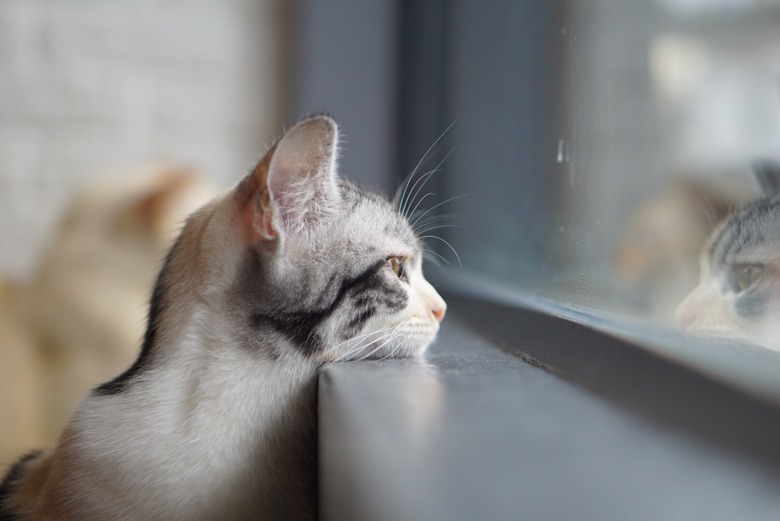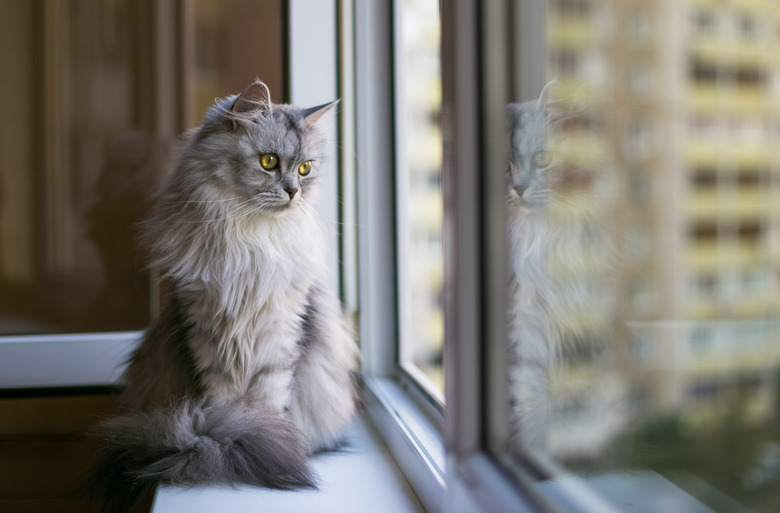Homemade Cat Guards For Screens
Cats can be very hard on door and window screens — they like to sharpen their claws on the screen material, and in doing so they tear up the fabric or wire mesh of the screen. It's essentially impossible to train a cat to stop scratching screens, particularly if more than one screen is involved. While you can give your cat a distraction with a scratching post, the best way to deal with the problem is to block off the screens so that the cat can't have access to them. There are several ways to approach a screen covering project without buying commercial screen guards.
Window screen guard for cats
Window screen guard for cats
One way to pet-proof screens is to replace old screens with sturdy, pet-proof screening. Most people should be able to do this, though it will probably require changing to a smaller spline, since pet-proof screens are thicker and heavier than conventional screening. The fiberglass screening material is available in different widths to fit almost any door or window. Experts recommend that you roll the new screen into the spline groove before you insert the spline.
Cover screens with acrylic panels
Cover screens with acrylic panels
Create a DIY cat window guard by using clear acrylic panels to cover the lower part of a screen door or a window screen to keep cats from being able to claw it. You can usually purchase these by the foot and cut them to desired size at the store, though you can cut acrylic at home without too much difficulty. Attach the plastic section directly to the screen's frame on the side that needs protection. Acrylic will block the airflow where it covers the screen, but it doesn't block the light.
Plastic DIY cat window guard
Plastic DIY cat window guard
A plastic window guard will cover a surface area while allowing you to see the outdoor view through the nearly invisible guard. These plastic guards can be easily attached to doors or windows with tape. This is a very easy cat screen protector to choose.
Install metal grills over screens
Install metal grills over screens
A metal grill that fits over the screen works well to keep cats away from a window or door screen. Many of these are made from aluminum or heavy-duty steel so they will hold up to your cat's claws. You'll find ready-made units on the retail market, but a homemade version is simple to construct. The main requirements are a piece of metal grill fabric with the right height and width, and screws to hold it in place. Typically, you can purchase this material at a building supply center and have it cut to order at the time of purchase.
Cover screening with plexiglass
Cover screening with plexiglass
An additional measure of security you can use to protect your precious screens from your cat's claws is a layer of plexiglass. Place a sheet of plexiglass over the bottom of your screen door. As long as your screen door can take the weight, your cat won't be able to sink their claws into the screen's netting.
Temporarily block screens with wood
Temporarily block screens with wood
For basic, immediate protection, you can cut a piece of wood to fit the screen so a cat can't access the screen material. This is most practical as an immediate, short-term solution such as when a cat's safety is at stake. Affix the wood directly to the screen's frame or to the window frame around the screen. A piece of 1/4-inch plywood will be adequate as it's ideal for blocking off cats from high windows and compromised screens that may allow them to escape. However, since wood blocks your view, you'll want to replace it with one of the other options.
It's natural for your cat to want to sharpen their claws on your door and window screens as they take in the view (and look for prey). In addition to blocking their access to screens, try getting them a cat tree where they can safely look outside, and take your cat to the vet to keep their claws trimmed.


